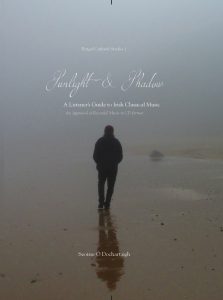Sunlight & Shadow
If you were in a record shop in France and asked the sales person to direct you to the section dealing with French music, you would most certainly be brought to a stall where the names of Debussy, Ravel, Berlioz, Saint–Saëns, Messiaen, et al. would be printed in large letters – and, of course, this music would be in the classical music section. If you went into a record shop in Ireland and asked to be directed to Irish music, you would be shown the CDs of The Chieftains, The High Kings, Van Morrison, Sinéad O’Connor, U2, The Cranberries, etc., and the sales person there would not think for a second that you meant Irish classical music.
And the reason for this eschewed categorization? The history of music-making on this island has caused serious confusion in people’s minds, both at home and abroad, about what exactly defines “Irish Music”. Most people believe that it is only defined by traditional jigs and reels alongside ballads sung with an Irish accent. Others familiar with sean-nós (a very old and particularly ornate form of unaccompanied singing in Gaelic) will be happy to tell you that sean-nós is Irish music par excellence. No argument here, but there is another kind of “Irish Music”, and it doesn’t always have an easily defined accent. It is called Irish Classical Music.
This guide book is a kind of history of Irish Classical Music, although the more correct term is Irish “art music”, since the classical period is confined to the years 1750-1820, give or take a handful. It’s a history not told chronologically, but reflected in a selection of CDs from a collection of about 300, and growing, some of them in box-sets.
CDs of Irish classical music can be viewed as stepping stones over a broad river; each one bringing you that little bit closer to the other side, i.e. to a greater understanding of and appreciation for this genre. You might learn as you go along that Ireland is a treasure house of recorded music which has, unfortunately, no special status in any music shop.
You will find the familiar names of Field, Balfe, Stanford, Harty and Ó Riada among what I call “our little pantheon” of Irish composers; but you will also discover here the somewhat lesser-known names of Victor Herbert, Augusta Holmès, Arthur O’Leary and George Osborne. You might be surprised at the unlikely names of Ludwig Van Beethoven, Benjamin Britten and Arthur Sullivan et al. swelling out the ranks with their arrangements of Irish folksongs and, believe it or not, an “Irish” Symphony from the latter. When viewed as a collective, the totality of Irish works adds up to a picture of a very healthy and varied musical tradition. I dare say some people will tell you such a thing does not exist at all, or at least would be somewhat sceptical of its existence.
However, CDs are there as proof. Record companies thought enough of the composers and their works to invest research, time and money into finding professional players and singers to perform this music; booking expensive recording studios; spending a lot of cash pressing the discs and paying printers and designers to come up with interesting cover-art and layouts. And all this is for you, the listener, to hold a CD in your hands (admiringly, one hopes) and go home and appreciate its visual and musical contents. And if not the CD, well…there’s the download!
The issuing of recordings is not an act of charity. People pay good money for the privilege of owning them. And while they are often hard to find in your local music store, they can be delivered to your door or your digital device through on-line services – just a mouse-click away. The good news is: they are not as expensive these days as they used to be and digital downloads are the price of an ice-cream. Happy listening!
